What sink siphon to choose and how to install it
Modern man is so accustomed to the communal benefits that, as a rule, does not think about how it all works. However, during repair or a point replacement of plumbing it is useful to know what siphons are. Now on the market there are several types of designs, ranging from the simplest corrugated and ending with such an uncommon variant as a dry siphon for a sink with a check valve. Next, we describe the classification and installation methods of these plumbing fixtures.

Why do I need a siphon
Everyone knows that any plumbing has a drain connected to the sewer system. But it is not clear to a simple man in the street why this knot, which stands under his sink and sometimes interferes, can one not immediately connect a pipe to the sewage system? And believe me, some unknowingly do so.
Branched pipework sewers, mostly empty, that is, liquid drains do not fill the pipes completely, they go only along the bottom, occupying the lower part of the space. The rest of the space is filled with so-called sewage gases, in other words, fumes. And if you don’t put a kind of stub in the path of these fumes, they will go straight to the apartment.
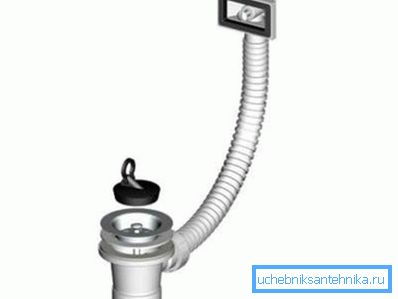
Siphon is precisely the very barrier that reliably protects your apartment from unpleasant and even dangerous odors. The design with a valve or a water seal, passes the drains only in one direction, preventing the gases from escaping back.
In addition to a reliable barrier to gases, it also performs the function of a kind of filter or sump. Large debris or municipal solid waste is trapped and is deposited precisely in the siphon, which is very convenient, because it is much easier to clean in comparison with sewage pipes.
Varieties of siphons
There are several types of constructions, it’s not possible to say that some of them are worse or better, they were simply developed for their own types of plumbing. Modern models differ not only in design features, but also in material.
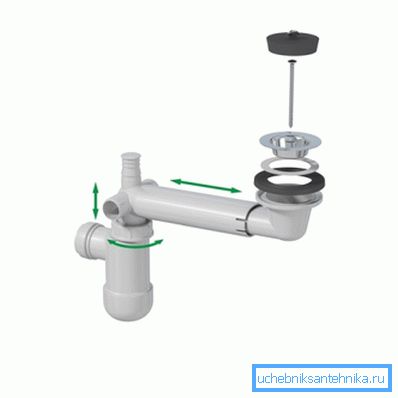
Corrugated option
This is the most simple and affordable model, its price, compared to the others, is the lowest. It is an ordinary plastic corrugated pipe (a pipe in a fold), curved in the form of a zigzag. As a result of this bending, a water seal is formed, and direct access to the sewer system is blocked.
This option is convenient for several reasons.
- The installation itself is very simple; you can fix such a bend with your own hands, either with a special plastic clamp, or simply by tying the pipe with a wire, this will not affect the quality of work.
- Corrugation, as you know, is well stretched, so this model is perfect if you need to move the sink to the side.
- And as already mentioned, all corrugated pipes are made of plastic, so the cost will be minimal.
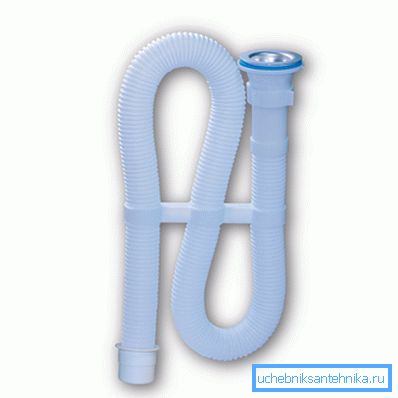
But not everything is so rosy. On the corrugated inner surface of such a pipe, fine debris, grease or soap layers will inevitably settle. Therefore, it will have to be cleaned much more often.
Pipe siphon
Although many experts distinguish this structure in a separate group, but in fact, it is practically the same as the above-described variant with a corrugated tube. The difference lies only in the material. If the corrugation itself is flexible and is made of plastic, then hard plastic or metal is used here.
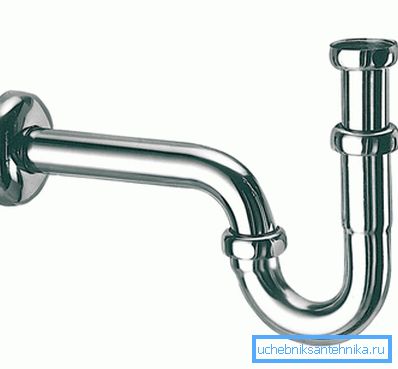
In the relatively recent past, such a structure was simply called a knee. The knee was made mainly of cast iron and was a deep bend, providing a permanent water seal. Now the same is being done, only from non-ferrous metals or stainless steel in a spectacular design.
The downside of such models is the low debris retention capacity; under great pressure, everything that can fit in a pipe will pass into the sewage system. But along with this, this option has a small size, so the knee is often used in the bathroom, for showers or as a siphon for the sink over the washing machine.
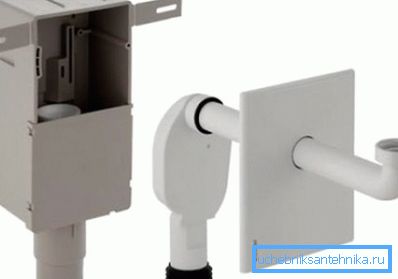
Bottle design
The bottle siphon for the sink got its name due to its similarity with the bottle. Structurally, it is a flask with a tap, into which a rigid drain pipe from the bowl of the sink vertically is inserted, a small gap is left between the bottom of the flask and the pipe. With the release of drains, everything is also simple, it is carried out through a drain hole located approximately in the middle of the flask.
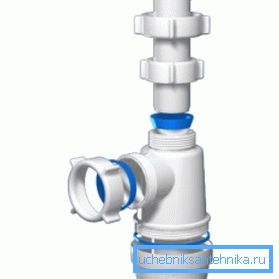
The result is a reliable water seal. The bottom of the flask is unscrewed, making it easy to remove small debris. The technical characteristics of the siphon for a bottle-type sink are considered the highest; for this reason, such constructions are used in kitchen sinks.
Important: there is a sump in the bottle siphons, so if a foreign object, such as a ring or chain, accidentally falls into the sink drain, you can immediately block the water and unscrew the bottom thicket of the glass to get the object.
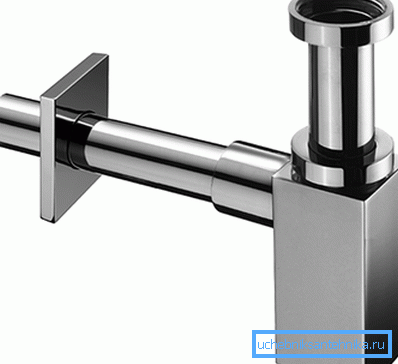
Custom models
Most non-standard models are made for complex assemblies, for example, when there is a need to connect several points to a siphon or to have two sinks at the same time.
But now a separate type of structures is being produced, in which the principle of a hydraulic lock is not used, these are the so-called dry siphons. In such products, a check valve made of soft rubber is installed. They let the fluid into the sewer and block the movement back. Such constructions are popular among summer residents, because in winter, dry siphons cannot freeze, as a result, the system is not torn.
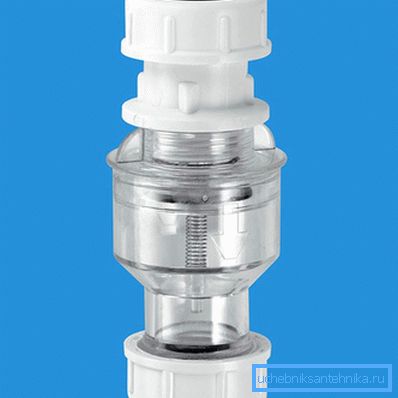
A few construction installation tips
Proper construction of the structure is important, and although the device is a siphon for the sink, in most cases similarly, errors during assembly can lead to an unpleasant odor in the room or even leakage.
Instructions for installing a bottle siphon is considered the most difficult, so we will look at it.
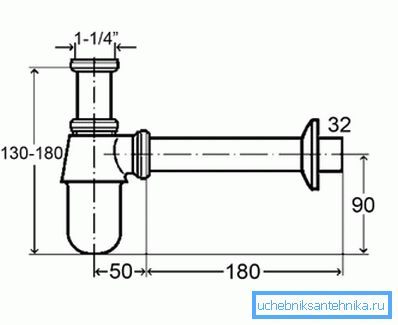
- Assembling the sink siphon begins with the installation of a protective grid inside the bowl. As a rule, the grille is made of metal and a thin rubber gasket is inserted under it, we will firmly fasten it later, while we only need to install it.
- From the bottom of the bowl, also through the gasket is installed a branch pipe. Most often, the metal nut is rigidly mounted in the fittings of the pipe, but sometimes there are models where it goes separately. After that, the grille and the pipe is twisted with a metal screw.
Tip: since most siphons are made of plastic, you should not make excessive efforts when tightening the threaded connections, they may break, and such fittings are not sold separately, so you have to buy a new siphon.
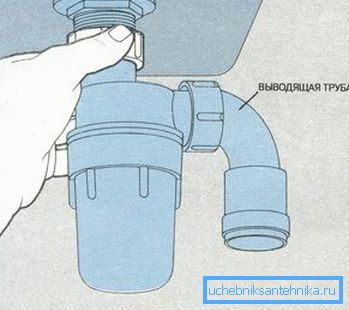
- At this stage it is important to clearly position the gaskets., because in the case of a shift, the system will start to leak.
- Bottom on the branch pipe you need to put on the connecting plastic nut, after which a cone-shaped gasket for the sink siphon is put in here.
- So, we have a rigidly installed pipe and it is wearing a nut and gasket. Next you need to take the flask itself and gently put it on the nozzle from below, after which the sealing gasket moves in and the nut is clamped. Please note that the nozzle should not rest against the bottom of the flask, leave a gap of at least 10 - 15 mm.
- After fixing the flask on the nozzle, you can install the bottom cover on it. There should also be a rubber gasket. The cover itself is twisted with reasonable effort.
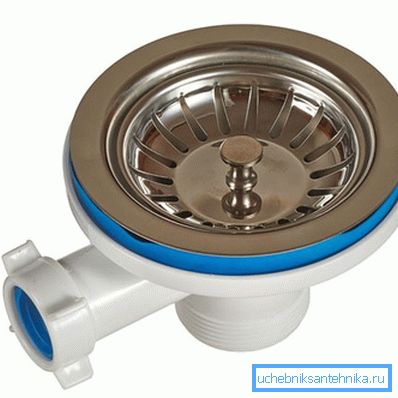
Tip: the bottom cover will have to be unscrewed regularly for cleaning, so you should not use silicone to seal. As a rule, there is enough rubber gasket, but if in doubt, you can reel the sealing fum tape.
- Next, we just have to connect the side outlet from the siphon to the sewer pipe.. This is done in approximately the same way as the connection to the upper nozzle. A nut and a tapered gasket are put on the branch pipe on the side, after which a soft corrugated or rigid connecting pipe is put on and tightened.
Note! It is undesirable to position the drain horizontally, the greater the angle of inclination, the less water will stagnate and blockages will form.
- Docking sewer pipe with a conclusion from the siphon is done through a rubber sealing cuff. Whether to lubricate it with silicone, decide for yourself, but often just insert the pipe and that's it.
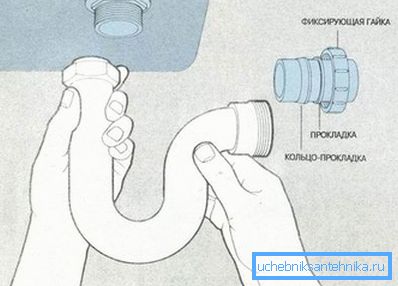
On the video in this article, you can observe the order of work.
Conclusion
Knowing what a siphon for the sink and having the skills of its installation, you can choose a quality model for any plumbing unit. And even if you do not want to build the system with your own hands, you can control the masters.
